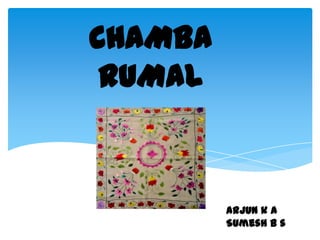
Chamba rumal
- 1. CHAMBA RUMAL Arjun k a Sumesh b s
- 2. Introduction The Chamba Rumal , is a form of embroidery that flourished in the eighteenth and early twentieth century in the mountain region of north India. Running through Chamba, Kulu, Kangra, Guler, Mandi and Suket, the craft witnessed explicit distinctions between 'elite' and 'folk art'. The languishing craft of the 'Chamba Rumal' refers only to the delicately embroidered rumals created by royal and elite women who had access to the professional services of trained miniature artists. These miniature artists not only drew the theme to be embroidered on the rumal in charcoal, but also provided the women who would be embroidering the rumal with a sophisticated colour palette
- 3. Location of Chamba Chamba is the north- western district of Himachal Pradesh. Founded during the 6th century, it is one of the oldest princely states in India. Chamba has a rich history of crafts including metal crafts, miniature paintings, weaving, leather work, wood carving, basketry and jewellery making.
- 4. Traditions • It was customary to gift embroidered rumals in a girl’s marriage. • Subjects like wedding scenes were popular and were repeatedly embroidered. • This handicraft , being an important item of the dowry, was dependent for its existence almost on the social custom i.e. wedding. • No marriage ceremony would be reckoned complete with out the gift of Chamba rumal by the relatives of the brides.
- 5. Raw material Traditionally, the fabric used to make the Chamba Rumal was hand-spun or hand-woven unbleached thin muslin or malmal. The most popular fabric , employed in Chamba rumals, was khaddar because of its availability, low cost and durability.
- 6. Threads The thread used for the embroidery was untwisted silk yarn, which, in the do - rukha stitch used in Chamba embroidery. This untwisted silk thread - usually made in Sialkot, Amritsar, and Ludhiana - was the same as that used in the Phulkari embroidery of the Punjab. Untwisted silken thread
- 7. Needle
- 8. STITCHES The stitch used in embroidering the Chamba Rumal was the do – rukha, double satin stitch which, as its name implies, can be viewed from two (do) sides or aspects (rukh). The stitch is carried both backward and forward and covers both sides of the cloth, effecting a smooth finish that is flat and looks like colours filled into a miniature painting. No knots are visible, and the embroidered rumal can be viewed from both sides. It thus becomes reversible.
- 9. Dandi Tanka - the stem stitch The outline in black thread is a marked characteristic, which is a conspicuous characteristic of the Chamba rumal. After filling the colourful threads in the figures and floral designs , these are finally enclose with a fine line worked out in black thread , which apparently lends the powerful affect as seen in pahari miniature painting
- 10. Criss Cross stitch The use of criss cross stitches , which comprise a simple technique of crossing two stitches of equal size in the shape of a cross (X) can be discerned in several rumals. This stitch as a unit comprises a running band mostly in red colour , arrayed usually in straight or circular line identically visible on the both sides of the fabric. This criss – cross stitch is no longer practiced by any contemporary embroider in Chamba .
- 11. MOTIFS •Animal and birds motifs are used along with human figures •Bird motifs - parrot, peacock, duck and swan • Animal motifs – tigers, horses, rams • Tree motifs – cypress and the plantain trees bent, laden with flowers and fruits.
- 12. MOTIFS
- 13. PROCESS STEP 1:
- 14. STEP 2 : Outlining of drawing with charcoal by the artist.
- 15. STEP 3 : Do-rukha embroidery done by the women folks.
- 17. Dice board
- 18. Radha-Krishna
- 19. Shikargah
- 22. Current designs, fabrics and tread used. Chamba Rumal on silk fabric with traditional motifs Currently, raw materials being used are cotton, malmal, silk, terricot and polyester fabrics. Both twisted and untwisted yarn is being used to do the embroidery. The affect and the beauty of the Chamba Rumal are clearly visible on the malmal or cotton. Other fabrics are mostly being used to bring down the costs of the rumal and sell it in the local market
- 23. Pahari painting in Chamba There is a strong link between pahari paintings and the embroidery on the rumals. The subject of the embroideries ranged from religious themes, embodying the strong Vaishnava fervour in the pahari regions, to themes from the great epics, the Ramayana, and the Mahabharata. Krishna surrounded by his gopis , godhuli(the hour of cow dust, with Krishna and his cow-herd friends bringing home the cows); the Radha- Krishna alliance are among the popular themes.
- 24. Important Works So far, the oldest dated rumal is a 16th century creation that is supposed to have been embroidered by Bebe Nanki, the sister of Guru Nanak, the founder of the Sikh faith in India. This is now preserved in the Sikh shrine in Gurdaspur in Punjab. A rumal depicting the battle of Kurukshetra - from the Indian epic Mahabharata - is to be found at the Victoria and Albert Museum in London. This oblong piece is supposed to have been presented by Raja Gopal Singh of Chamba to the British in 1833.
- 25. Bibliography Books Indian textiles,by John Gillow Crafts of Himachal Pradesh , by Subhashlni Aryan Indian Embroidery, by Irwin and Hall The techniques of indian embroidery, by Anne Morrell Indian Embroidery, by Jamila Brijbhushan Fabric art heritage of india, by Sukladas
